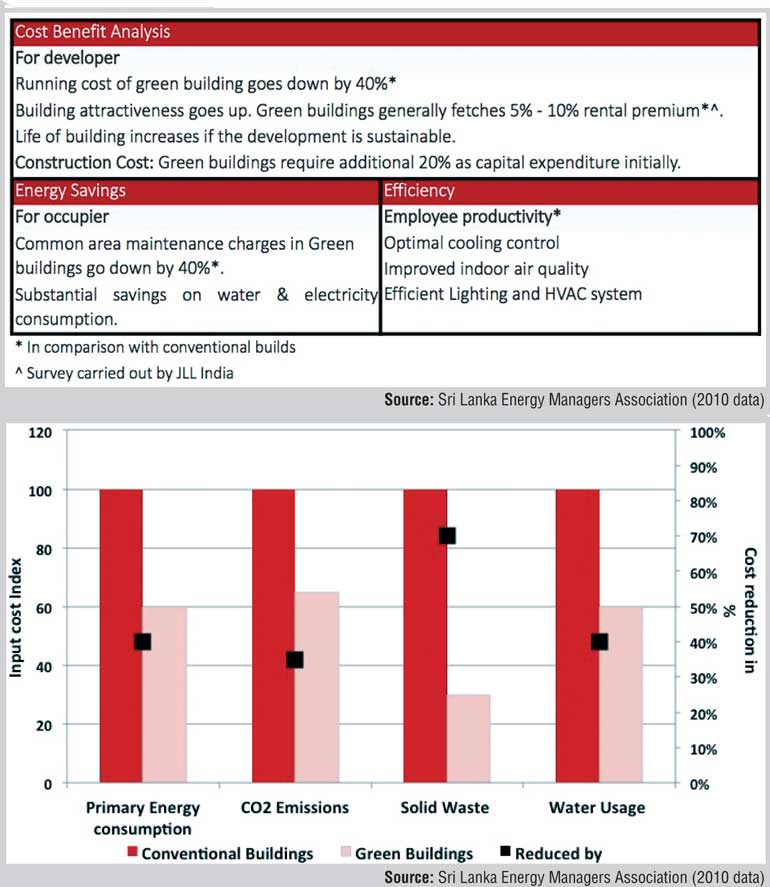Friday Mar 21, 2025
Friday Mar 21, 2025
Monday, 10 August 2015 00:00 - - {{hitsCtrl.values.hits}}
Country with natural green cover is moving towards imbibing ‘green’ in the construction sector says Gagan Singh, Chairperson – Jones Lang LaSalle Sri Lanka

Gagan Singh
With the onset of political stability, Sri Lanka has actively pursued a policy of vigorous industrial and economic growth. Emerging now is an island that is being reshaped through the utilisation of its natural bounty and undertaking of major construction activity to drive its economic engine of development.
It would serve the country well, if during this initial phase itself, the concepts of sustainability and green architecture are made the underlying pillars for frenetic construction underway in the major cities. It is not as if ‘green’ is a novel concept for the island nation. The Sri Lanka chapter of Green Building Council has been in place since 2009 and already uses the Leadership in Energy and Environmental Design (LEED) and ‘Green SL’ rating systems. Developers and industry participants are already enthusiastic to move towards green building practices.
There are already instances of a few green projects in Sri Lanka and select projects are under construction.
The factory has become a benchmark and an international award winner for eco-friendly manufacturing and its commitment to environmental best practices.
The advantages of green buildings in terms of cost savings for occupiers as well as developers have been well-documented.
The concerns regarding green buildings being ‘expensive’ compared to conventional buildings have been dispelled as the operational savings over the project lifecycle far outweigh the costs. Economies of scale for such projects enable the cost differential for ‘green buildings’ to also reduce gradually. While imbibing green architecture and energy efficient processes results in a better work environment and employee productivity, the conservation of nature also remains a key concern which can be mitigated to an extent by using green techniques for the ‘built’ environment.

Sri Lanka’s way forward
As a developing country, construction activity across different asset classes and infrastructure development will be accompanied by some amount of environmental degradation and increased carbon emissions. Hence, the bottom-up approach of sustainable architecture has to be combined with the energy efficiency parameters to achieve truly green buildings.
A host of global corporate firms have committed to future real estate growth in green projects. An increased focus by commercial developers in this direction will definitely enable more corporate expansion within the country.
Sri Lanka has started on the right path by evolving a local rating system along with LEED. This will allow for a gradual learning and operationalisation of green buildings on a bigger scale. As techniques and practices become more industry-intensive, Sri Lanka will be able to grow while maintaining a harmonious balance with its environment.
A regulatory framework which can make certain elements of resource conservation and optimum utilisation mandatory for a certain scale of projects will go a long way in creating a robust form of self-governance and new industry practices.
As the country takes baby steps towards energy-efficient green buildings, it can apply lessons from other countries and do it right in development of their real estate. If the right construction practices are adopted, green development rate could grow multi-fold in the coming years – boding well for Sri Lanka.
Discover Kapruka, the leading online shopping platform in Sri Lanka, where you can conveniently send Gifts and Flowers to your loved ones for any event including Valentine ’s Day. Explore a wide range of popular Shopping Categories on Kapruka, including Toys, Groceries, Electronics, Birthday Cakes, Fruits, Chocolates, Flower Bouquets, Clothing, Watches, Lingerie, Gift Sets and Jewellery. Also if you’re interested in selling with Kapruka, Partner Central by Kapruka is the best solution to start with. Moreover, through Kapruka Global Shop, you can also enjoy the convenience of purchasing products from renowned platforms like Amazon and eBay and have them delivered to Sri Lanka.
Discover Kapruka, the leading online shopping platform in Sri Lanka, where you can conveniently send Gifts and Flowers to your loved ones for any event including Valentine ’s Day. Explore a wide range of popular Shopping Categories on Kapruka, including Toys, Groceries, Electronics, Birthday Cakes, Fruits, Chocolates, Flower Bouquets, Clothing, Watches, Lingerie, Gift Sets and Jewellery. Also if you’re interested in selling with Kapruka, Partner Central by Kapruka is the best solution to start with. Moreover, through Kapruka Global Shop, you can also enjoy the convenience of purchasing products from renowned platforms like Amazon and eBay and have them delivered to Sri Lanka.